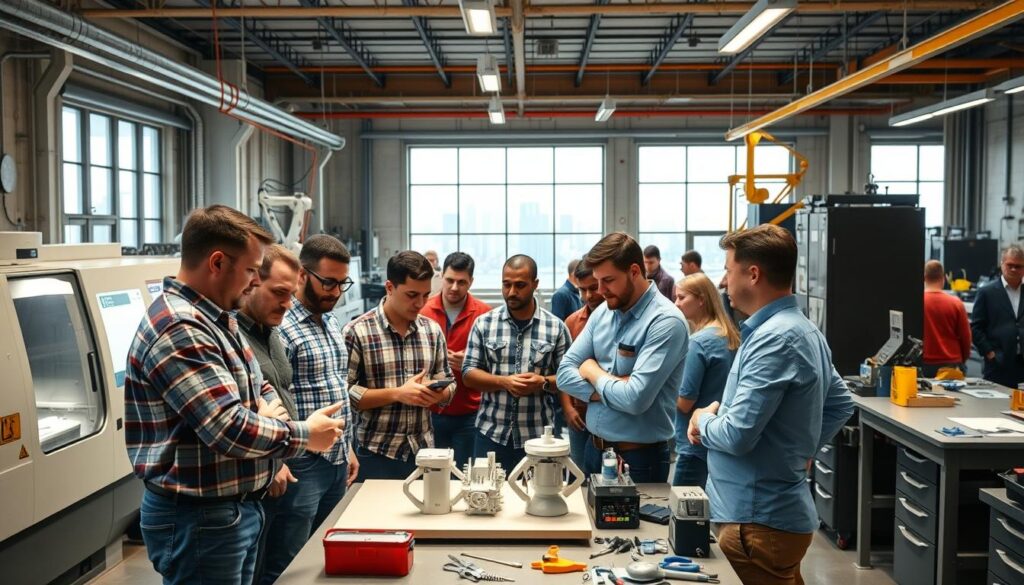Did you know that teams with optimized engineering capacity can boost productivity by up to 30%? This significant improvement can be the difference between meeting project deadlines and falling behind. Elevating your team’s capabilities is crucial in today’s fast-paced technological landscape.
By focusing on capacity building in engineering, organizations can maximize efficiency, enhance collaboration, and achieve breakthrough results. This involves implementing comprehensive development solutions tailored to the team’s needs.
Key Takeaways
- Optimized engineering capacity can increase productivity by up to 30%.
- Capacity building in engineering enhances team collaboration and efficiency.
- Comprehensive development solutions are crucial for achieving breakthrough results.
- Elevating team capabilities is vital in today’s technological landscape.
- Focusing on capacity development leads to improved project outcomes.
Understanding Engineering Capacity Development
To unlock the full potential of engineering teams, understanding capacity development is essential. It involves a comprehensive approach to enhancing engineering skills and fostering an environment conducive to professional development for engineers.
Definition and Importance
Engineering capacity development refers to the process of improving the skills, abilities, and knowledge of engineering professionals within an organization. This development is crucial as it directly impacts the organization’s ability to innovate, solve complex problems, and deliver high-quality projects. Effective capacity development ensures that engineers are equipped with the latest technologies and methodologies, thereby enhancing their productivity and contribution to the organization.
Performance management plays a significant role in capacity development. It is a continuous process that involves planning work and setting expectations, monitoring performance, developing an employee’s capacity to perform, rating performance, and rewarding success. By adopting a robust performance management system, organizations can identify areas where engineers need training or development, thereby facilitating targeted capacity development initiatives.
Benefits for Organizations
The benefits of engineering capacity development for organizations are multifaceted. Firstly, it leads to improved project delivery times and quality, as engineers are better equipped to handle complex tasks. Secondly, it enhances innovation, as a skilled and knowledgeable workforce is more likely to develop novel solutions. Lastly, it aids in talent retention, as engineers are more likely to stay with an organization that invests in their professional growth.
- Improved project delivery times and quality
- Enhanced innovation and problem-solving capabilities
- Better talent retention and attraction
Key Components of Capacity Development
Capacity development in engineering encompasses several key components. These include training and development programs, mentorship opportunities, and the use of technology to facilitate learning and collaboration. Additionally, creating a culture that encourages continuous learning and innovation is vital. Organizations must also focus on professional development for engineers by providing them with opportunities to attend conferences, workshops, and other industry events.
| Component | Description | Benefits |
|---|---|---|
| Training Programs | Structured training sessions on latest technologies and methodologies | Enhanced skills and knowledge |
| Mentorship | Guidance from experienced professionals | Personalized development and career guidance |
| Technology Use | Utilization of digital tools for learning and collaboration | Increased efficiency and accessibility |
Assessing Your Organization’s Current Engineering Capacity

To unlock your team’s potential, it’s vital to assess your organization’s current engineering capacity. This assessment is the foundation upon which effective capacity development strategies are built. It involves understanding the current strengths and weaknesses of your engineering workforce.
There’s no shortage of commentary on engineering metrics, but too often, teams obsess over metrics without clarity about why they’re measuring or whether they’re genuinely improving. Effective assessment is not just about collecting data; it’s about deriving actionable insights that can inform training programs, such as those focused on engineering workforce training.
Tools for Capacity Assessment
Several tools and methodologies can be employed to assess engineering capacity. These include:
- Skills assessments to identify knowledge gaps
- Performance metrics to evaluate current productivity and efficiency
- Surveys and feedback mechanisms to understand team perceptions and needs
Utilizing these tools effectively requires a clear understanding of what you’re trying to measure and why. For instance, skills assessments can help identify areas where engineering workforce training programs can be beneficial.
| Assessment Tool | Purpose | Outcome |
|---|---|---|
| Skills Assessments | Identify knowledge gaps | Targeted training programs |
| Performance Metrics | Evaluate productivity and efficiency | Improved project delivery times |
| Surveys and Feedback | Understand team needs and perceptions | Enhanced team satisfaction and engagement |
Identifying Strengths and Weaknesses
Once the assessment is complete, the next step is to identify the strengths and weaknesses of your engineering team. This involves analyzing the data collected and drawing meaningful conclusions. It’s about understanding where your team excels and where it needs improvement.
For example, your team might have a strong background in traditional engineering practices but lack experience in newer technologies. This insight can guide your engineering workforce training initiatives, ensuring they are tailored to address specific needs.
Setting Clear Goals for Capacity Development
Clear goals are the foundation upon which successful capacity development strategies are built. To achieve engineering talent advancement, organizations must first define what they aim to accomplish.
Aligning Goals with Organizational Strategy
At GitHub, the process begins with clarifying goals: what business outcomes need to be achieved, and how does engineering performance directly influence these outcomes? Aligning capacity development goals with the overall organizational strategy ensures that efforts are focused and effective.
| Goal Alignment Aspect | Description | Benefits |
|---|---|---|
| Business Outcomes | Identify key business outcomes that engineering capacity impacts. | Ensures engineering efforts are aligned with business objectives. |
| Engineering Performance | Assess how engineering performance influences business outcomes. | Helps in understanding the role of engineering in achieving business goals. |
| Strategic Objectives | Align capacity development goals with the organization’s strategic objectives. | Enhances the relevance and impact of capacity development initiatives. |
SMART Goals Framework
Utilizing the SMART goals framework is crucial for creating clear and achievable goals. SMART stands for Specific, Measurable, Achievable, Relevant, and Time-bound.
- Specific: Clearly define what is to be achieved.
- Measurable: Quantify goals to track progress.
- Achievable: Ensure goals are realistic based on resources and constraints.
- Relevant: Align goals with the organization’s overall strategy.
- Time-bound: Establish deadlines for achieving goals.
By following the SMART framework, organizations can create a roadmap for capacity development that is both ambitious and achievable.
Building a Competent Engineering Team

In today’s fast-paced technological landscape, building a competent engineering team is more important than ever. A team’s competence directly influences an organization’s ability to innovate, solve complex problems, and stay ahead of the competition.
Importance of Skills Diversity
A diverse set of skills within an engineering team is crucial for tackling a wide range of challenges. Skills diversity not only enhances problem-solving capabilities but also fosters innovation. By bringing together individuals with different backgrounds and expertise, organizations can leverage a broader spectrum of ideas and approaches.
For instance, collaboration between engineering and sales departments in the manufacturing and engineering sectors can lead to significant benefits for product development and market success. This interdisciplinary approach ensures that products are both technically sound and meet market needs.
Recruitment Strategies
Effective recruitment is key to building a competent engineering team. Organizations should adopt strategic recruitment practices that go beyond traditional hiring methods. This includes leveraging social media, attending industry conferences, and utilizing professional networks to find top talent.
- Utilize online platforms and job boards specifically targeting engineering professionals.
- Engage in industry events and conferences to network with potential candidates.
- Offer competitive packages and opportunities for growth and development.
Moreover, organizations can benefit from exploring innovative approaches to software engineering, which can be a significant factor in attracting top talent in the field.
Retention of Engineering Talent
Retaining engineering talent is just as important as recruiting it. Organizations must create an environment that supports continuous learning and professional growth. This can be achieved through regular training programs, mentorship opportunities, and a culture that encourages innovation and experimentation.
“The best engineers are not just looking for a job; they’re looking for a challenge. Organizations that can provide a stimulating environment and opportunities for growth are more likely to retain top talent.”
By focusing on skills diversity, adopting effective recruitment strategies, and prioritizing talent retention, organizations can build a competent engineering team that drives success and innovation.
Training and Development Programs
To unlock the full potential of engineering teams, organizations must invest in comprehensive training and development programs. These programs are designed to enhance the skills and knowledge of engineers, driving engineering career growth and contributing to the overall success of the organization.
Types of Training Initiatives
Organizations can implement various types of training initiatives to cater to the diverse needs of their engineering teams. Some effective options include:
- Technical skills training to keep engineers updated with the latest technologies and tools.
- Soft skills training to enhance communication, teamwork, and leadership abilities.
- Mentorship programs that pair experienced engineers with junior team members.
Best Practices for Effective Training
To ensure the effectiveness of training programs, organizations should follow best practices such as:
- Conducting thorough needs assessments to identify skills gaps.
- Customizing training content to meet the specific needs of the team.
- Using a mix of training methods, including hands-on exercises and theoretical sessions.
Evaluating Training Outcomes
Evaluating the outcomes of training programs is crucial to understanding their impact on engineering career growth and team performance. Organizations can use various metrics, such as:
- Feedback surveys to gauge participant satisfaction.
- Quizzes and assessments to measure knowledge retention.
- Performance metrics to track improvements in job performance.
By implementing these strategies, organizations can create effective training and development programs that support the continuous growth and development of their engineering teams.
Fostering a Culture of Continuous Improvement

To achieve engineering excellence, organizations must cultivate an environment that thrives on continuous improvement. This involves creating a culture where teams are encouraged to innovate, learn from failures, and adapt to new challenges.
According to GitHub Executive Insights, reimagining engineering success involves measuring with purpose, investing in improvements, and building a learning culture. This approach not only enhances engineering capabilities but also drives organizational growth.
Encouraging Innovation
Innovation is the backbone of continuous improvement. Engineering teams should be encouraged to explore new ideas and approaches. This can be achieved by:
- Providing resources and time for side projects
- Fostering collaboration across different departments
- Recognizing and rewarding innovative efforts
By doing so, organizations can create an environment where creativity thrives, and teams are motivated to push boundaries.
Implementing Feedback Mechanisms
Feedback is crucial for continuous improvement. It helps identify areas of strength and weakness, allowing teams to refine their strategies. Effective feedback mechanisms include:
- Regular code reviews
- Retrospectives and post-project analyses
- Continuous integration and testing
For more insights on how continuous improvement can build a competitive edge, visit McKinsey’s insights.
By implementing these strategies, engineering teams can foster a culture of continuous improvement, leading to enhanced capabilities and better outcomes.
Leveraging Technology for Capacity Development
The integration of technology in engineering practices is revolutionizing the way teams develop their capacity. By embracing the right tools and platforms, organizations can significantly enhance their engineering capabilities.
Tools and Software for Engineers
Engineers today have access to a wide array of tools and software that can streamline their workflow, improve collaboration, and enhance productivity. Some of the most impactful tools include:
- Version control systems like Git
- Project management software such as Jira or Asana
- Collaboration platforms like Slack
- Design and simulation tools like Autodesk or SolidWorks
These tools not only improve the efficiency of engineering tasks but also facilitate better communication among team members.
Online Learning Platforms
Online learning platforms have become indispensable for continuous learning and skill development in engineering. Platforms such as Coursera, Udemy, and edX offer a wide range of courses tailored to the needs of engineers.
For instance, GitHub’s approach to meaningful improvements through intentional listening and actionable investments underscores the importance of continuous learning. By leveraging online learning platforms, engineers can stay updated with the latest technologies and methodologies.
Use of Data Analytics
Data analytics plays a crucial role in enhancing engineering skills by providing insights into project performance, team productivity, and areas for improvement. By analyzing data, organizations can make informed decisions to optimize their engineering processes.
| Data Analytics Application | Benefits |
|---|---|
| Project Performance Monitoring | Identify areas for improvement, optimize resource allocation |
| Team Productivity Analysis | Enhance collaboration, streamline workflows |
| Skill Gap Analysis | Targeted training programs, improved skill development |
By leveraging technology, including tools, software, online learning platforms, and data analytics, organizations can significantly enhance their engineering capacity development efforts.
Industry Collaborations and Partnerships

Strategic partnerships are essential for driving professional development for engineers and advancing engineering workforce training. By collaborating with other industry players, organizations can leverage each other’s strengths, leading to enhanced innovation and competitiveness.
Industry collaborations yield numerous advantages, including enhanced product development, elevated customer satisfaction, increased revenue, and accelerated time-to-market. These benefits are crucial for organizations aiming to stay ahead in the competitive engineering landscape.
Importance of Networking
Networking is a critical component of industry collaborations. It allows organizations to establish connections with potential partners, stay updated on industry trends, and identify new opportunities for growth. Effective networking can lead to the formation of strategic alliances that drive mutual benefits.
To foster a strong network, organizations should participate in industry events, conferences, and trade shows. These platforms provide opportunities to meet potential partners, learn about the latest industry developments, and showcase their own capabilities.
How to Form Strategic Alliances
Forming strategic alliances requires careful planning and execution. Organizations should start by identifying potential partners that align with their goals and values. The next step is to establish a clear understanding of what each party brings to the table and what they hope to achieve through the partnership.
For more information on forming partnerships, visit the National Institute of Biomedical Imaging and website, which provides insights into bioengineering partnerships with industry.
| Benefits of Industry Collaborations | Description | Impact |
|---|---|---|
| Enhanced Product Development | Collaborative innovation leads to better products | Increased customer satisfaction |
| Elevated Customer Satisfaction | Better products and services meet customer needs | Increased loyalty and retention |
| Increased Revenue | New products and services open up new revenue streams | Improved financial performance |
| Accelerated Time-to-Market | Streamlined development processes reduce launch times | Competitive advantage |
Measuring the Impact of Capacity Development
The success of skills development in engineering hinges on the ability to measure and analyze the impact of capacity development programs. Metrics are powerful, but only if they’re aligned to your purpose. Too often, teams track everything simply because they can rather than because they should.
To effectively measure the impact, organizations must first identify what they aim to achieve through their capacity development initiatives. This could range from improving project delivery times to enhancing the overall quality of engineering work.
Key Performance Indicators (KPIs)
KPIs are quantifiable measures used to evaluate the success of an organization in achieving its objectives. For engineering talent advancement, relevant KPIs might include:
| KPI | Description | Target |
|---|---|---|
| Project Completion Rate | Percentage of projects completed on time | >90% |
| Training Participation | Percentage of engineers participating in training programs | >80% |
| Skill Proficiency | Average skill level of engineers post-training | 85% |
Regularly Reviewing Progress
It’s not enough to simply set KPIs; regularly reviewing progress against these indicators is crucial. This involves:
- Regular check-ins to assess progress
- Adjusting strategies based on KPI outcomes
- Communicating results to stakeholders
By regularly reviewing progress and adjusting strategies as needed, organizations can ensure their capacity development initiatives are on track to meet their engineering talent advancement goals.
Case Studies of Successful Capacity Development

Through the lens of various case studies, we can understand the elements that contribute to successful capacity development. Organizations that have invested in enhancing their engineering capabilities offer valuable lessons for others looking to improve their own capacity.
Overview of Notable Organizations
Several organizations have made significant strides in engineering capacity development. For instance, Tipteh, an industrial automation specialist, leveraged a 3D visualization tool to provide their engineers with comprehensive insights into machine design. This strategic move not only enhanced their design process but also improved overall engineering capabilities.
Another example is a leading manufacturing firm that implemented a comprehensive training program focused on emerging technologies. This initiative resulted in a notable increase in employee skills and a significant reduction in project timelines.
Lessons Learned from Real-World Examples
Analyzing these case studies reveals several key takeaways:
- Innovative Tools and Technologies: Adopting cutting-edge tools like 3D visualization can significantly enhance engineering design and capabilities.
- Comprehensive Training Programs: Investing in employee development through structured training programs can lead to improved skills and efficiency.
- Strategic Planning: Aligning capacity development goals with organizational strategy is crucial for success.
As noted by industry experts, “Investing in capacity development is not just about technology; it’s about people and processes.” This underscores the importance of a holistic approach to improving engineering capabilities.
“The use of 3D visualization tools has revolutionized our design process, allowing for more precise and efficient machine design.” – Tipteh Engineer
| Organization | Strategy | Outcome |
|---|---|---|
| Tipteh | Adoption of 3D Visualization Tool | Enhanced Design Process |
| Manufacturing Firm | Comprehensive Training Program | Increased Employee Skills, Reduced Project Timelines |
These case studies demonstrate that with the right strategies, organizations can achieve significant engineering career growth and improving engineering capabilities. By learning from these examples, other organizations can tailor their own capacity development initiatives for success.
Addressing Challenges in Capacity Development
The journey to enhance engineering capacity is fraught with challenges that need to be addressed. As organizations strive to improve their engineering workforce training, they often encounter obstacles that can hinder their progress. Effective capacity building in engineering requires a comprehensive approach that not only identifies these challenges but also implements strategies to overcome them.
One of the key data points highlighting the importance of addressing these challenges is the merging of engineering and marketing. This integration is vital for delivering products that not only embody technical excellence but also meet market demands and drive revenue. By understanding this intersection, organizations can better navigate the complexities of capacity development.
Common Barriers to Success
Several common barriers can impede the success of capacity building initiatives in engineering. These include:
- Limited resources and budget constraints
- Lack of skilled personnel and inadequate training programs
- Resistance to change within the organization
- Insufficient infrastructure and technology
Understanding these barriers is crucial for developing effective strategies to overcome them. For instance, a study by a leading engineering firm highlighted that inadequate training programs were a significant obstacle to capacity development. The firm addressed this by implementing a comprehensive training initiative that resulted in a 25% increase in productivity.
| Barrier | Impact | Potential Solution |
|---|---|---|
| Limited Resources | Reduced capacity for project execution | Prioritize projects, seek external funding |
| Lack of Skilled Personnel | Inability to meet project demands | Develop training programs, recruit skilled workers |
| Resistance to Change | Slow adoption of new technologies and processes | Change management programs, leadership buy-in |
Strategies for Overcoming Challenges
To overcome the challenges in capacity development, organizations can adopt several strategies. These include:
- Developing a clear and comprehensive capacity development plan
- Investing in ongoing training and development for engineering staff
- Fostering a culture of innovation and continuous improvement
- Leveraging technology to enhance engineering capabilities
As noted by industry experts, “Capacity building is not a one-time effort but a continuous process that requires commitment and strategic planning.” By adopting these strategies, organizations can enhance their engineering workforce training and achieve their capacity development goals.
“The key to successful capacity development lies in understanding the unique needs of your organization and tailoring your approach accordingly.”
By addressing the common barriers to success and implementing effective strategies, organizations can unlock their full potential and drive growth through enhanced engineering capacity.
Sustainability in Engineering Capacity Development

The integration of sustainable practices in engineering is no longer optional but a necessity for long-term success. As organizations strive to reduce their environmental footprint, engineering capacity development plays a crucial role in achieving these sustainability goals.
Companies like Rivian, the electric vehicle manufacturer, are at the forefront of this movement. Rivian’s commitment to innovation and sustainability is evident in its global operations, where it emphasizes fast, efficient, and environmentally-friendly processes. This approach not only enhances their engineering talent advancement but also contributes to a more sustainable future.
Long-term Success Strategies
To achieve long-term success, organizations must adopt strategies that prioritize sustainability. This includes investing in skills development in engineering that focus on green technologies and sustainable practices. By doing so, companies can ensure that their engineering teams are equipped to develop innovative, eco-friendly solutions.
- Implementing sustainable practices in daily operations
- Investing in renewable energy sources
- Fostering a culture of innovation and environmental stewardship
Environmental Considerations in Engineering
Environmental considerations are integral to modern engineering practices. Engineers must consider the environmental impact of their designs and processes, striving to minimize waste and reduce carbon footprints. This not only benefits the environment but also enhances the organization’s reputation and compliance with environmental regulations.
By integrating environmental considerations into engineering capacity development, organizations can drive engineering talent advancement while contributing to a sustainable future.
Future Trends in Engineering Capacity Development
The future of engineering capacity development is poised to be shaped by emerging technologies and innovative practices. As companies strive to stay competitive, there is a significant opportunity for them to enhance their engineering effectiveness and collaborative capacity between departments to achieve strategic success.
Emerging Skills and Technologies
The engineering landscape is rapidly evolving, with new technologies and methodologies emerging at a swift pace. To remain relevant, engineers must continually update their skills to incorporate the latest advancements. Some of the key emerging skills include:
- Proficiency in data analytics and interpretation
- Understanding of Internet of Things (IoT) devices and their applications
- Knowledge of sustainable engineering practices
- Familiarity with collaborative software and tools
Enhancing engineering skills in these areas will not only boost individual capabilities but also contribute to the overall capacity development of the organization.
The Role of Artificial Intelligence
Artificial Intelligence (AI) is set to play a pivotal role in the future of engineering capacity development. AI can automate routine tasks, provide insights through data analysis, and even assist in complex problem-solving. For professional development for engineers, AI offers personalized learning experiences and predictive analytics to identify skill gaps.
Key Applications of AI in Engineering:
| Application | Description | Benefit |
|---|---|---|
| Predictive Maintenance | AI algorithms predict equipment failures | Reduces downtime and increases efficiency |
| Design Optimization | AI assists in optimizing design parameters | Improves product performance and reduces costs |
| Personalized Learning | AI-driven platforms offer tailored training | Enhances skill development and knowledge retention |
By embracing AI and other emerging technologies, organizations can significantly enhance their engineering capacity, driving innovation and competitiveness in the market.
Promoting Diversity and Inclusion in Engineering

In today’s complex engineering landscape, promoting diversity and inclusion is vital for improving engineering capabilities. Fostering teamwork and collaboration is essential, and a diverse and inclusive environment plays a crucial role in achieving this.
Importance of Diverse Perspectives
Diverse perspectives bring a wealth of ideas and approaches to problem-solving, enhancing the overall quality of engineering projects. By embracing diversity, organizations can leverage a broader range of experiences and insights, leading to more innovative solutions. For more information on measuring diversity and inclusion in engineering, refer to this report.
Best Practices for Inclusion
Creating an inclusive culture involves more than just policies; it requires a commitment to fostering an environment where everyone feels valued. Best practices include providing training on unconscious bias, promoting flexible work arrangements, and ensuring equal opportunities for career advancement. By implementing these practices, organizations can enhance their engineering capacity development efforts.
Ultimately, a diverse and inclusive engineering team is better equipped to tackle complex challenges and drive innovation, contributing to the overall success of the organization.
Engaging Stakeholders in the Capacity Development Process

Stakeholder engagement is essential for driving engineering career growth and capacity building in engineering. Effective collaboration between different departments, such as engineering and sales, is crucial for driving product development and market success. By engaging stakeholders, organizations can ensure that their capacity development initiatives are aligned with overall business objectives.
Identifying Key Stakeholders
The first step in engaging stakeholders is to identify who they are. Key stakeholders in the capacity development process may include:
- Engineering team members
- Department heads and senior management
- Customers and end-users
- Suppliers and partners
Understanding the roles and interests of these stakeholders is vital for developing effective engagement strategies.
Communication Strategies
Effective communication is the backbone of successful stakeholder engagement. Organizations should employ a variety of communication strategies to keep stakeholders informed and involved. This can include:
- Regular progress updates
- Stakeholder meetings and workshops
- Transparent reporting on capacity development initiatives
As emphasized by a leading expert, “Clear and consistent communication helps build trust and ensures that all stakeholders are working towards the same goals.”
“The art of communication is the language of leadership.”
Engaging stakeholders through effective communication not only fosters a collaborative environment but also drives the success of capacity development initiatives.
By focusing on stakeholder engagement and implementing robust communication strategies, organizations can significantly enhance their capacity building in engineering efforts, leading to improved engineering career growth and overall business success.
Creating a Tailored Capacity Development Plan

Creating a tailored capacity development plan is crucial for enhancing your team’s engineering capabilities. This plan serves as a roadmap for identifying the specific needs of your engineering workforce and addressing them effectively.
A well-structured plan not only boosts the skills of your engineers but also aligns with the overall organizational strategy. It involves assessing the current capacity, setting clear goals, and implementing targeted training programs.
Steps to Creating Your Plan
To create an effective capacity development plan, follow these steps:
- Assess your current engineering capacity to identify strengths and weaknesses.
- Set SMART (Specific, Measurable, Achievable, Relevant, Time-bound) goals that align with your organizational strategy.
- Develop a comprehensive training program that addresses the identified gaps.
- Implement the training program and monitor its progress regularly.
- Evaluate the outcomes and make necessary adjustments to the plan.
A Latin American bank’s experience serves as a valuable case study. Initially, the bank struggled with unclear roles and responsibilities, hindering its digital transformation. By restarting with clearly defined expectations and responsibilities, the bank was able to successfully transform its digital strategy.
Examples of Customized Programs
Customized programs can vary widely depending on the organization’s needs. For instance, a company might focus on skills development in engineering by offering specialized training in emerging technologies such as AI and machine learning.
Another example is an organization that implements an engineering workforce training program tailored to its specific project requirements, ensuring that engineers have the necessary skills to deliver projects efficiently.
These examples demonstrate the importance of tailoring capacity development plans to meet the unique needs of each organization.
Conclusion: The Way Forward for Engineering Teams
As organizations strive for excellence in today’s competitive landscape, enhancing engineering skills and driving engineering talent advancement are crucial. By understanding the importance of engineering capacity development, organizations can unlock their teams’ potential and drive success.
Key Takeaways
The journey to enhancing engineering skills involves assessing current capacity, setting clear goals, and fostering a culture of continuous improvement. By leveraging technology, industry collaborations, and tailored development plans, organizations can ensure their engineering teams remain at the forefront of innovation.
Unlocking Potential through Collaboration
To drive product development and market success, it’s essential to unlock the potential of collaboration within your organization. For expert guidance on staffing and recruitment solutions in the technology, engineering, and manufacturing sectors, consider reaching out to Techneeds today.
